 Contact Us | Change Text Size | Search Site
Contact Us | Change Text Size | Search Site
About Bridge Multimedia
Services
Accessible Media Development
Audio Description
Bilingual & ELL
Captioning
Extra InfoTM
Products
EdTech Online:
U.S. Dept. of Education EdTech Grant Directory
Emergency Preparedness Online
WEIGHTS
More
Emergency Preparedness Online,
Fifth Edition
A resource directory for emergency preparedness, response, recovery, and accessible communications
Next: The UN International Strategy for Disaster Reduction
Previous: The Satellite Broadcasting and Communications Association
NHK & Current EAS Research & Development in Japan
A. General Information
NHK (Nippon Hoso Kyokai - Japan Broadcasting Corp) has led the research and development of emergency broadcasting technology since the late 1970's. In 2000, the Japanese government mandated that all broadcasters convert to digital terrestrial broadcast systems and that there will be no more analog broadcast by 2011. As emergency broadcast technology existed in analog broadcast systems in the past, emergency alert systems (EAS) are being implemented into the digital systems of today. Having the ability to reach many people through portable devices and digital television, this EAS technology is increasingly becoming a important aspect of emergency broadcasting.
Many technology companies have also joined the effort to refine the emergency broadcasting technology, such as Panasonic, Fujitsu, and KDDI.
B. Digital Television
Partly funded by National Institute of Information and Communications Technology (NICT), Panasonic has developed the following technology for emergency broadcast.
-
Data Broadcast Interruption/Push technology
A technology offering flexible switching and simultaneous data broadcast by Automated Program Controller (APC) at broadcast stations.
-
The Dynamic Broadcast Bandwidth Controller
A technology that maximizes emergency data broadcast depending on the content of current programming.
These technologies make it possible for automated switching to emergency broadcast as requested by local and other agencies, with scalable response depending on emergency level, and without interrupting the normal data broadcast. For example, the TV system will automatically switch to emergency data broadcasting without use of remote control by viewers. This way, the public can receive emergency data broadcast immediately and reliably.
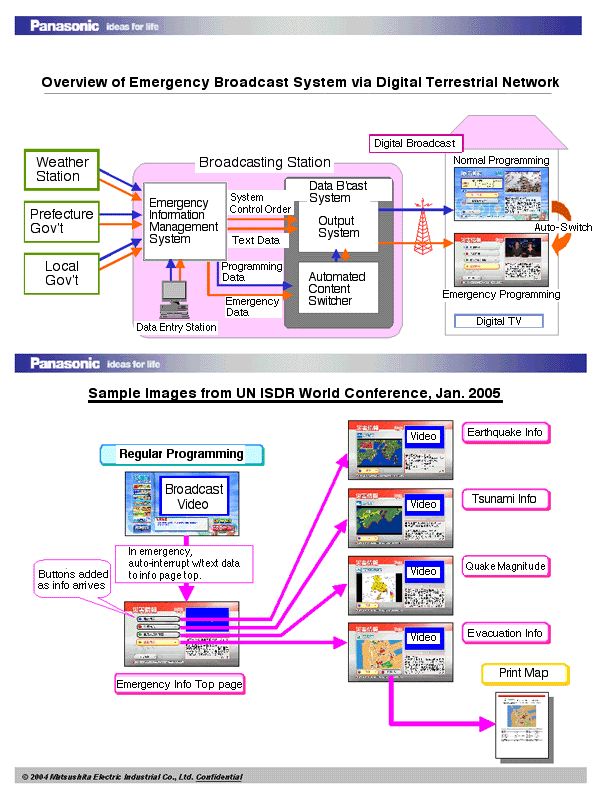
C. Portable Devices
In spring of 2006, Digital Terrestrial Network will begin broadcasting specifically to portable devices, such as cell phones and portable TVs. One of the challenges in emergency broadcast is to design portable devices to automatically activate on demand to alert users. It has been difficult for such devices to "standby" for Emergency Warning Signals (EWS) for an extended period of time due to limited battery power. NHK has been successful in developing new portable devices with minimal power consumption. The new design lets these portable devices wait for Emergency Warning Signals in a specified narrow frequency, thereby saving power. This also allows the device to fully respond and receive data in areas of weak signal. A similar circuit design can be incorporated into TV remote control, so it can automatically turn on television in emergency situations. NHK is currently incorporating this new design into commercially available portable devices.
The encoder/decoder (codec) used in broadcasting to portable devices is AVC/H.264, which can accommodate 320x240 video at maximum 15 frames per second. The bit rate is very low at 128-192kbps. NHK recently developed a real time encoder to keep the quality as high as possible. The video signal is processed before the encoding to remove noise, smooth transitions and complicated patterns, resulting in reduced pixilation and blocking artifacts. The process spots areas that are susceptible to degradation such as facial images, and emphasize those areas to retain maximum details. This device is slated for launch in early 2006.
BML is a language based on XML and XHTML, and users can customize which data to be sent/received via digital data broadcast. Using BML, if, for example, a user creates a preset to send the device's GPS location, it receives the nearest evacuation information. These portable devices can also take advantage of BML data broadcasting in conjunction with their built-in GPS and email capabilities.
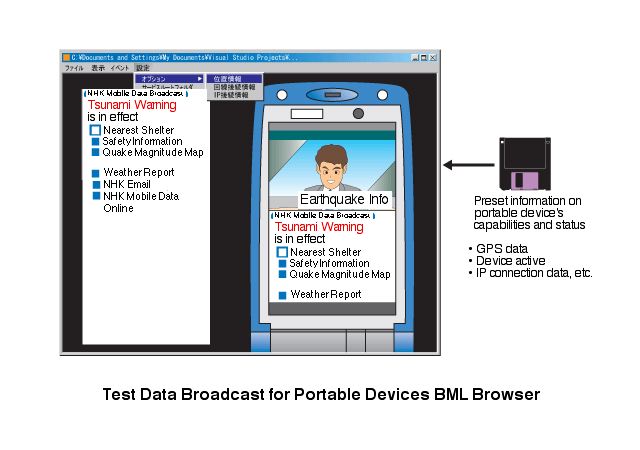
D. Accessible "Barrier Free" Technology
NHK has been researching broadcast technology for people with disabilities utilizing principles of universal design, known in Japan as "barrier free" technology. Some of the functionalities include converting text data to larger sizes/braille/synthesized speech, and real-time captioning technology with automated voice recognition.
-
Technologies for Blind and Visually Impaired
For blind or visually impaired individuals, NHK is developing various devices that can convert graphic and text information in data broadcast, as well as extracting text, subtitles, and emergency broadcast information in normal broadcast into:
- Large size text or high-contrast colors
- Interactive touch screen pad that can display graphic information and menu/button items
- Natural sounding synthesized speech
From data broadcast and via the Internet, blind and visually impaired people can potentially receive information via Braille display, touch display (graphic shapes or menu items that are selectable), or synthesized speech. For those with limited vision, graphic letters and subtitles can be magnified, or converted to synthesized speech.
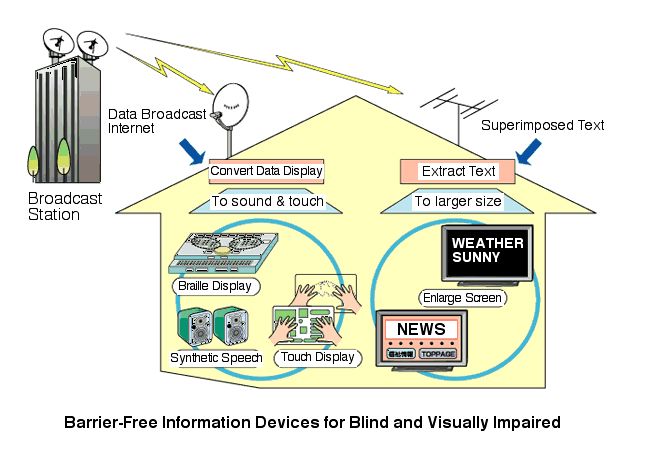
-
Technologies for Deaf and Hearing Impaired
NHK has developed technologies to capture and create captions live by voice recognition, called the RE-SPEAK Captioning System. During live broadcast of sporting events or concerts, the captioning narrator re-reads what's being spoken, and a computer then converts it to captioning data. Not only can this process help create error-free captions when there is much background noise, but the captioning narrator can modify the original narration in order captioning more easily understood by the deaf/hard of hearing viewer.
The captioning narrator's voice is recognized through his/her voice characteristics profile, and statistical probability of words spoken in each context. This is achieved by analyzing past episode of the show, and increases the accuracy of the captioning.
The RE-SPEAK Captioning System has been used in variety of programming such as Winter Olympics, Sumo Wresting tournament, Battle of Singers and other live broadcast. Many viewers reported positively, that they enjoyed the programs more by learning additional information missing in video content.
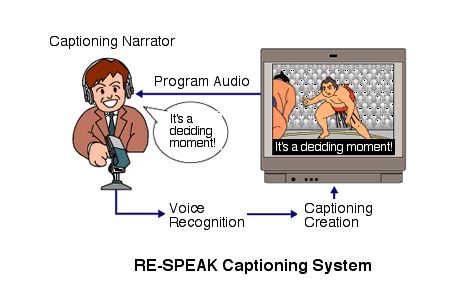
-
Audio Mix for the hard of hearing
Many hard of hearing individuals have said that they have difficult time understanding dialog or narrators while watching TV. For better understanding, NHK has created a secondary audio mix with lowered background sound. NHK is in the developmental phase of providing these additional mixes for within program offerings.
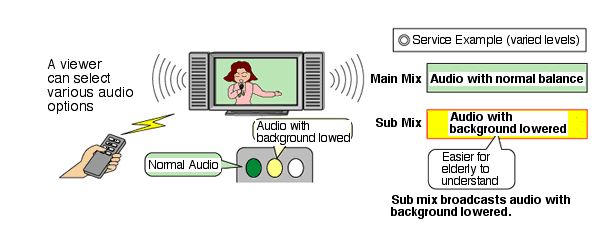
Previous: The Satellite Broadcasting and Communications Association
Return to top of page

